Transforming your shaded outdoor spaces doesn’t have to be a gardening challenge. We’ve discovered that shade window boxes can become stunning focal points that rival their sun-loving counterparts. While many gardeners assume limited sunlight means limited options, we’re here to prove that wrong.
Shade-tolerant plants offer incredible diversity in colors, textures, and growth patterns. From lush ferns that create dramatic backdrops to colorful begonias that pop against darker corners, we’ve found countless varieties that actually prefer cooler, shadier conditions. These plants often require less water and maintenance than traditional sun plants.
Creating beautiful shade window boxes isn’t just about choosing the right plants – it’s about understanding how to combine them for maximum visual impact. We’ll show you how to select plants that complement each other while thriving in low-light conditions, ensuring your window boxes remain vibrant throughout the growing season.
Best Foliage Plants for Shade Window Boxes
Selecting the right foliage plants transforms ordinary shade window boxes into stunning displays of color and texture. We’ve identified three exceptional foliage varieties that deliver consistent visual impact throughout the growing season.
Coleus for Vibrant Color Variations
Coleus plants offer the most diverse color palette available for shade window boxes, featuring combinations of burgundy, lime green, purple, pink, and yellow. These tropical annuals produce striking patterns including solid colors, speckled varieties, and multi-toned leaves that create instant visual drama. We recommend varieties like ‘Wizard Mix’ for compact growth and ‘Kong’ series for larger, more dramatic foliage displays.
Maintenance requirements for coleus remain minimal, requiring only regular watering and occasional pinching of flower spikes to maintain vibrant leaf color. These plants adapt well to various shade conditions, from partial to full shade, making them versatile choices for different window box locations. Temperature tolerance ranges from 60-75°F, ensuring consistent performance during warm weather months.
Caladium for Heart-Shaped Drama
Caladium bulbs produce some of the most elegant foliage available for shade gardening, with heart-shaped leaves displaying intricate patterns of white, pink, red, and green. These tropical plants excel in humid conditions and filtered light, creating sophisticated displays that rival any flowering plant arrangement. Popular varieties include ‘White Christmas’ for pure white centers and ‘Pink Beauty’ for soft rose-colored patterns.
Planting caladiums requires warm soil temperatures above 65°F, making them perfect for late spring through early fall displays. We suggest combining different caladium varieties to create layered color schemes that maintain interest throughout the season. These plants prefer consistent moisture without waterlogging, thriving in well-draining potting mixtures with organic matter.
Hosta for Classic Elegance
Hosta varieties provide timeless appeal for shade window boxes, offering diverse leaf sizes, colors, and textures that complement any architectural style. These perennial plants feature options ranging from miniature varieties like ‘Blue Mouse Ears’ to medium-sized selections such as ‘Patriot’ with its cream-edged green leaves. Variegated hostas create particularly striking displays with their distinctive color patterns and architectural form.
Durability sets hostas apart from annual alternatives, as these plants return year after year with proper winter protection. We recommend selecting container-appropriate varieties that won’t outgrow window box dimensions, focusing on compact cultivars that maintain proportional scale. These plants tolerate deep shade better than most alternatives while producing occasional flower spikes that add vertical interest to foliage displays.
Flowering Shade Window Box Plants That Bloom Beautifully
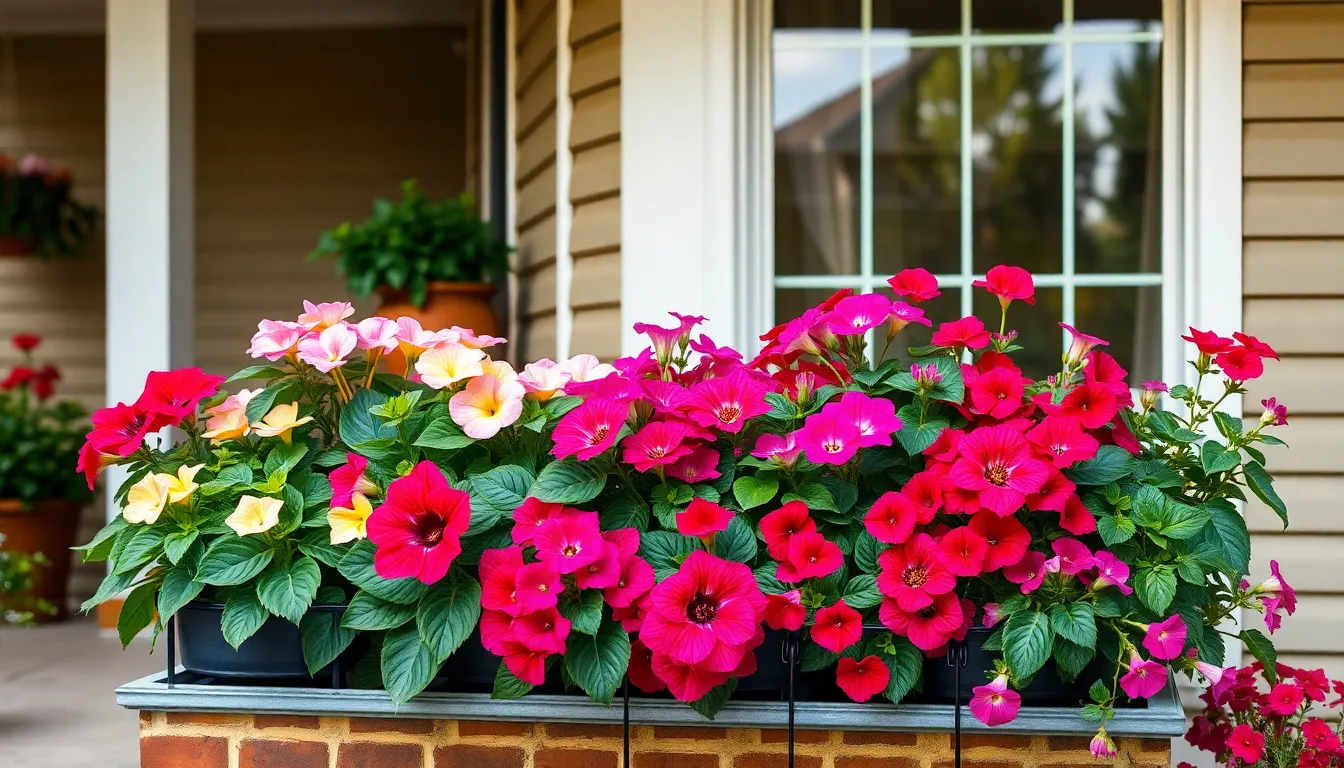
Now that we’ve covered stunning foliage options, let’s explore flowering plants that’ll bring vibrant color to your shaded window boxes. These shade-loving bloomers prove that limited sunlight doesn’t mean sacrificing beautiful flowers.
Impatiens for Continuous Color
Impatiens remain the gold standard for shade window boxes, delivering nonstop blooms from spring through summer. These classic flowers thrive in partial shade conditions and offer an impressive color palette including pink, red, orange, purple, and white varieties. We love how easy they are to maintain with minimal care requirements.
Pairing impatiens with ferns or hostas creates a lush, layered arrangement that maximizes visual impact. Their long blooming period ensures your window boxes stay colorful throughout the entire growing season. Well-drained soil keeps these reliable performers happy and healthy in shaded locations.
Begonias for Long-Lasting Blooms
Begonias excel as versatile shade-tolerant plants available in both upright bedding and cascading trailing varieties. These hardy bloomers prefer partial shade and consistently moist soil conditions, rewarding gardeners with extended flowering periods. We appreciate their diverse size options and extensive color range that complements any design scheme.
Starting begonias from seed or purchasing established plants both work well for window box installations. Their ability to add both vibrant color and interesting texture makes them invaluable for creating sophisticated shade displays. Long-lasting blooms ensure your investment pays off with months of continuous beauty.
Torenia for Unique Wishbone Flowers
Torenia brings distinctive charm to shade window boxes with its unusual wishbone-shaped flowers and vivid color combinations. These unique bloomers thrive in shaded spots where other flowering plants might struggle. We find their small but striking flowers add delightful diversity beyond traditional impatiens and begonias.
Creating attractive window box displays becomes easier when combining torenia’s distinctive form with other shade lovers. Their tolerance for low-light conditions makes them perfect for north-facing windows or heavily shaded areas. Including coleus, ferns, and ivy alongside torenia provides height variation and foliage contrast for complete visual balance.
Trailing Shade Plants Perfect for Cascading Effects
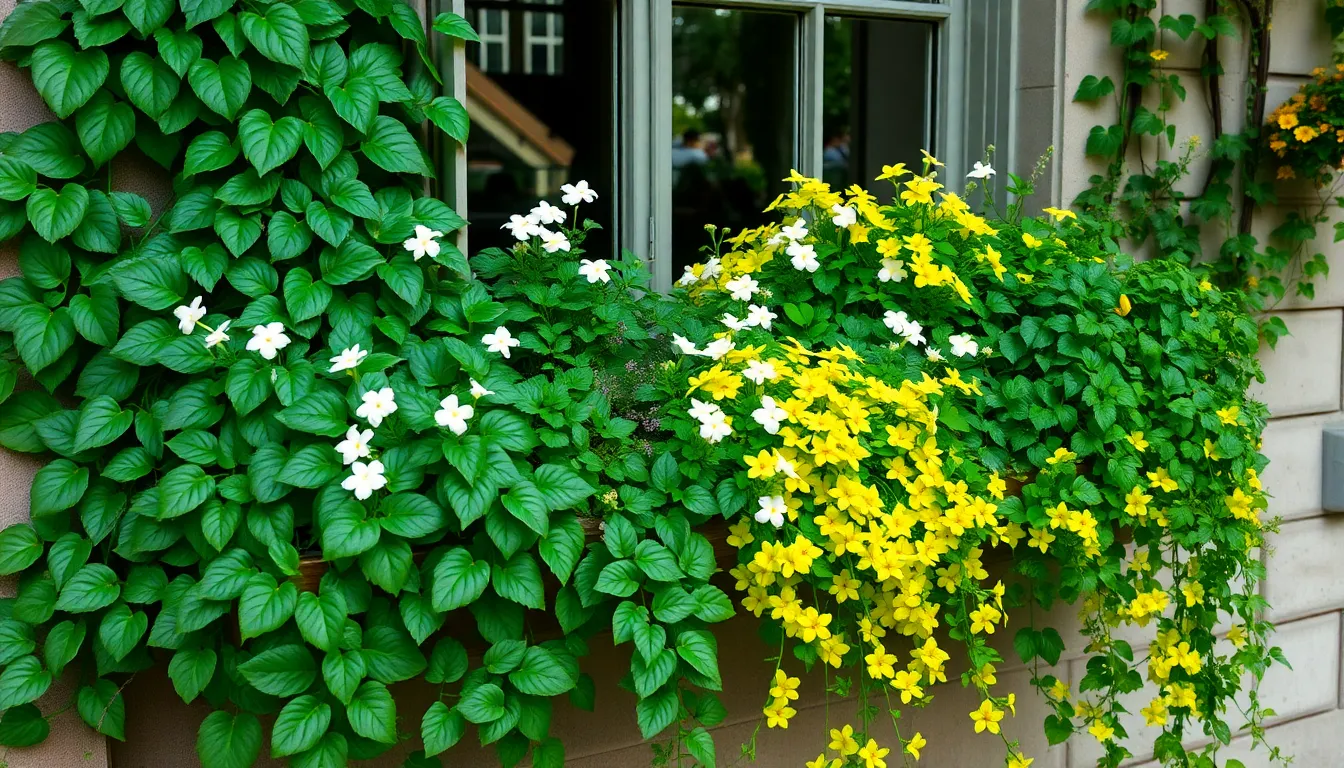
Transform your shade window boxes into stunning displays with trailing plants that spill gracefully over the edges. These cascading varieties add depth and movement while thriving in low-light conditions.
Ivy for Evergreen Coverage
Ivy stands out as our top choice for year-round greenery in shade window boxes. This evergreen climber provides consistent trailing coverage that looks beautiful in every season. We love how ivy creates a lush backdrop that perfectly complements colorful flowering plants like begonias or impatiens.
The plant’s hardy nature means it requires minimal maintenance while delivering maximum visual impact. Its dense foliage adds rich texture to window box arrangements and works especially well when paired with seasonal bloomers. Consider ivy your foundation plant that keeps window boxes looking full and vibrant even when other plants go dormant.
Bacopa for Delicate White Flowers
Bacopa brings elegant softness to shade window boxes with its graceful trailing habit and abundant small white flowers. This charming plant thrives in partial to full shade conditions while producing delicate blooms throughout the growing season. We find bacopa particularly effective at brightening darker arrangements with its light-colored flowers.
The plant’s gentle cascading growth pattern creates beautiful spillover effects that soften harsh window box edges. Its continuous blooming habit ensures your display maintains color and interest from spring through summer. Bacopa pairs wonderfully with darker foliage plants like hostas or coleus, creating striking contrast in your shade arrangements.
Creeping Jenny for Golden Accents
Creeping Jenny offers vibrant golden-yellow foliage that cascades beautifully from shade window boxes. This trailing plant provides stunning color contrast against darker green companions like ivy or hostas. We appreciate how its bright chartreuse leaves illuminate shaded areas and add warmth to cooler color schemes.
The plant’s vigorous trailing growth creates impressive spillover effects that can extend well beyond your window box edges. Its golden foliage maintains its brilliant color even in shade conditions, making it an excellent choice for creating focal points. Creeping Jenny works particularly well when combined with purple-leaved plants like certain coleus varieties or caladiums for dramatic color combinations.
Low-Maintenance Shade Window Box Plants for Busy Gardeners
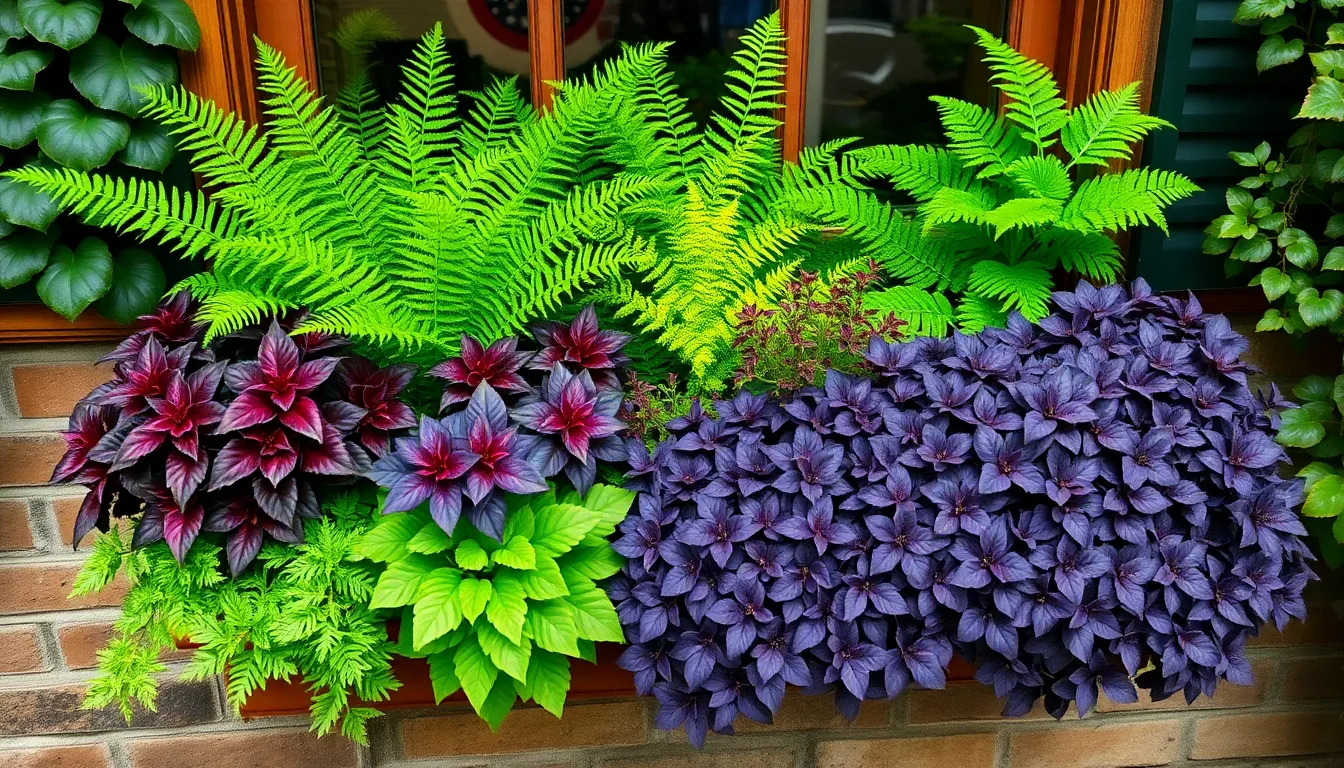
Finding the perfect shade window box plants shouldn’t add stress to your busy schedule. We’ve identified three exceptional varieties that thrive in low light conditions while requiring minimal care.
Ferns for Effortless Greenery
Ferns deliver lush, evergreen interest to your shade window boxes without demanding constant attention. These resilient plants naturally thrive in shady spots and prefer moist, well-drained soil conditions. Autumn ferns particularly excel in shadier environments, making them ideal candidates for your low-maintenance container gardens.
We love how ferns require only occasional watering and never need deadheading. Their graceful fronds create a classic backdrop for other plants while maintaining their beauty throughout the growing season. Simply provide consistent moisture and watch these elegant plants flourish in your shade window boxes.
Heuchera for Year-Round Interest
Heuchera transforms shade window boxes into colorful displays that last beyond blooming seasons. Also known as coral bells, these durable perennials offer vibrant foliage in stunning purples, reds, and greens that provide visual appeal year-round. Their adaptability to container conditions makes them perfect for busy gardeners seeking lasting beauty.
We appreciate how Heuchera tolerates shade exceptionally well while adding rich texture and color to window box arrangements. These plants maintain their attractive foliage even when not producing flowers, ensuring your containers remain visually interesting throughout multiple seasons. Their low-maintenance nature means you can enjoy gorgeous displays without frequent care routines.
Ajuga for Ground-Covering Beauty
Ajuga creates stunning ground-covering effects in shade window boxes while requiring minimal maintenance once established. This shade-tolerant plant produces attractive foliage and spikes of blue flowers that add vertical interest to your containers. We find its spreading habit particularly beneficial as it covers soil surfaces, helping suppress weeds and retain moisture naturally.
Drought tolerance makes Ajuga especially practical for busy gardeners who can’t water daily. The plant thrives in partial to full shade conditions and needs only occasional watering after it’s established. Its ability to spread and fill space creates lush, full-looking window boxes that appear professionally designed with minimal effort on your part.
Herbs That Thrive in Shade Window Boxes
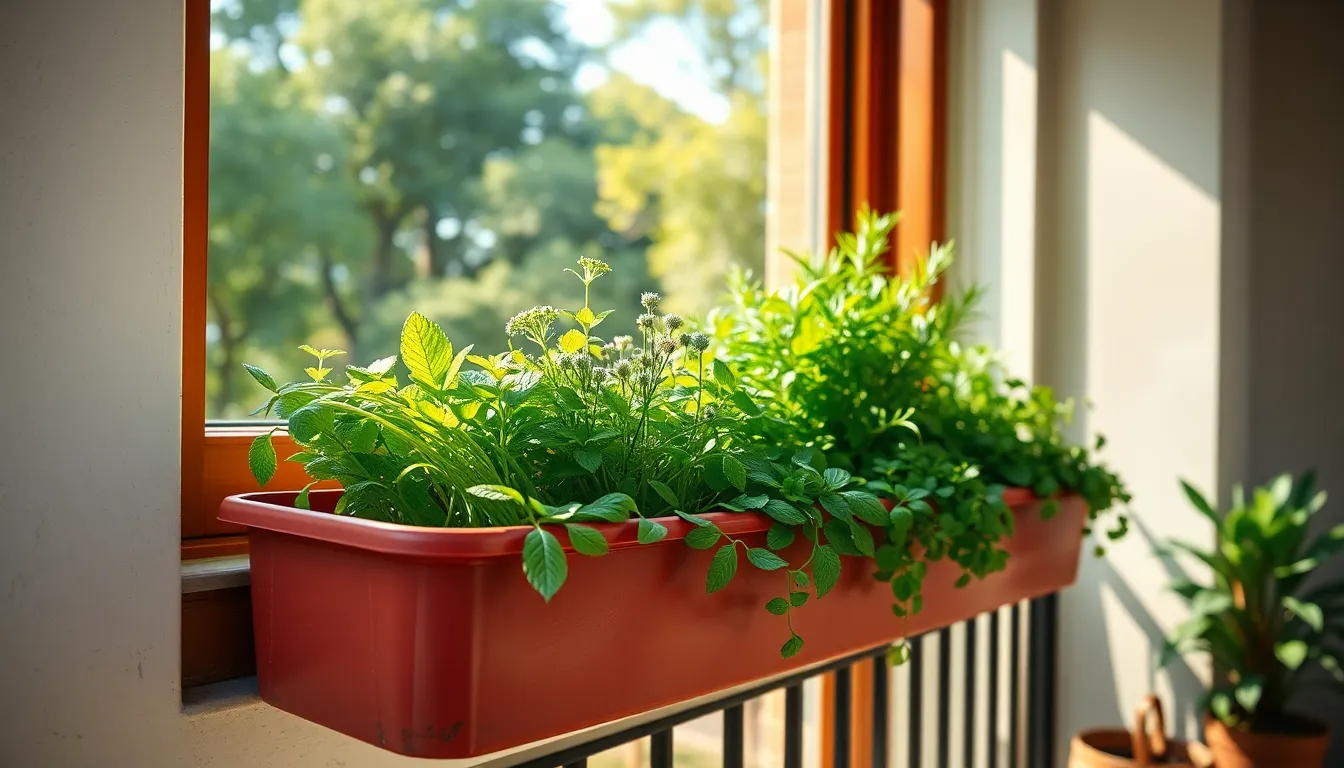
Transitioning from decorative plants to functional options, we can enhance our shade window boxes with herbs that serve both culinary and aesthetic purposes. These shade-tolerant varieties offer fresh flavors while requiring minimal sunlight.
Mint for Culinary and Aromatic Value
Mint stands out as the perfect herb for shady window boxes because it thrives in partial to full shade conditions. We’ll find this vigorous grower flourishes in the moist environments that shade locations naturally provide. Strong culinary applications make mint invaluable for flavoring teas, desserts, and savory dishes throughout the growing season.
Refreshing aromatic qualities fill the air around our window boxes whenever we brush against the leaves. Vigorous spreading habits mean we should plant mint in containers to control its growth and prevent it from overtaking other herbs. Continuous harvesting actually encourages more growth, giving us fresh mint leaves whenever we need them for cooking or beverages.
Parsley for Fresh Kitchen Herbs
Parsley prospers exceptionally well in shade or partial shade locations, making it our go-to fresh kitchen herb for less sunny window boxes. Quick growth patterns allow us to harvest continuously for cooking, salads, and garnishes without depleting the plant. Nutritional benefits complement the fresh flavor parsley adds to our meals.
Relatively low maintenance requirements make parsley ideal for busy gardeners who want fresh herbs without constant attention. Both flat-leaf and curly varieties perform well in shade conditions, giving us options for different culinary preferences. Regular harvesting keeps the plants productive and prevents them from going to seed too quickly.
Chives for Subtle Onion Flavor
Chives flourish beautifully in partial shade conditions, making them perfectly suited for window boxes that don’t receive direct sunlight all day. Subtle onion-like flavor enhances dishes without overpowering other ingredients when we snip them fresh. Slender, grass-like leaves add attractive texture to our shade herb gardens while providing continuous harvests.
Simple harvesting involves cutting the leaves as needed, and they’ll regrow quickly for repeated use. Purple flowers appear in late spring, adding unexpected color to our herb collection while remaining edible themselves. Low water requirements make chives particularly suitable for the naturally moist conditions that shade window boxes maintain.
Seasonal Shade Window Box Plant Combinations
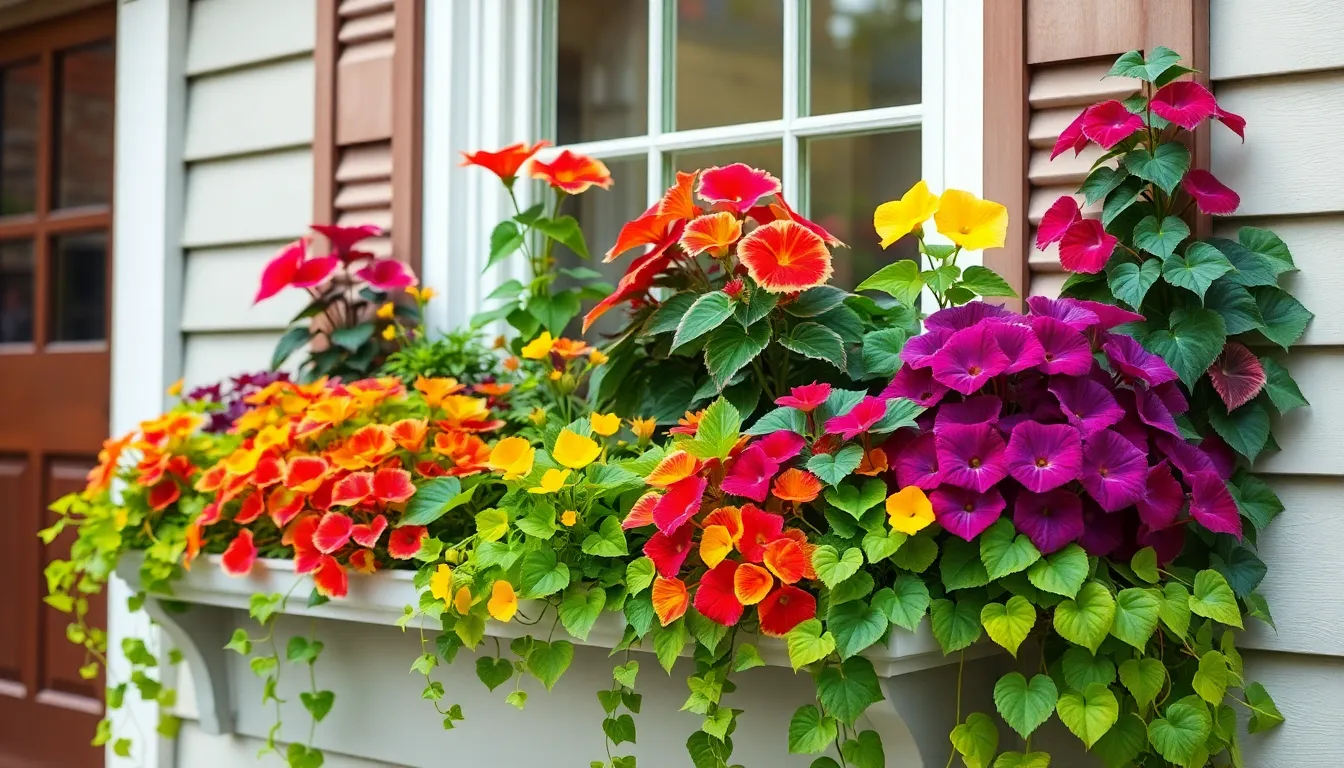
Different seasons call for exact plant combinations that thrive in shaded conditions while providing maximum visual impact. We’ll explore the best seasonal arrangements to keep your shade window boxes vibrant year-round.
Spring Combinations for Cool Weather
Coleus paired with begonias creates an outstanding foundation for spring shade boxes. We recommend selecting coleus varieties for their height and colorful foliage, which provides structure as the centerpiece of your arrangement. Begonias complement this setup perfectly with their bright blooms that perform exceptionally well in partial shade conditions.
Trailing ivy adds the cascading element that transforms basic plantings into professional-looking displays. This combination works effectively because all three plants tolerate cool spring temperatures while establishing strong root systems for the growing season ahead.
Cool weather tolerance makes these plants ideal for early spring planting when temperatures fluctuate between warm days and cool nights. We’ve found this combination provides immediate color and texture, filling shade boxes with vibrant displays from the moment you plant them.
Summer Arrangements for Hot Months
Surefire Rose or Red Begonia benariensis delivers exceptional performance during summer’s hottest months. These varieties offer long bloom times and superior heat tolerance, thriving in partial sun to shade conditions that characterize most window box locations.
Heart to Heart Caladium brings vibrant leaf color that adapts beautifully to both sun and shade environments. We particularly appreciate how these plants maintain their striking patterns and colors throughout summer’s challenging weather conditions.
Japanese painted fern or maidenhair fern provides fresh green accents that cool down hot summer arrangements. These ferns excel in container growing and add textural contrast to the bold colors of begonias and caladiums, creating balanced summer displays that withstand heat stress.
Fall Displays for Autumn Color
Coleus varieties with deep reds and purples transform summer arrangements into autumn masterpieces. We select these particular color variations because they echo fall’s natural palette while maintaining the structural height that anchors your display.
Boxwood adds structural evergreen elements that maintain form and color as summer flowers begin to decline. This strategic addition ensures your window boxes retain their appeal throughout fall’s transition period.
Trailing ivy softens edges while adding seasonal interest that carries displays into winter months. This combination approach allows you to transition gradually from summer’s bright blooms to fall’s rich foliage displays, extending your window box season significantly.
Essential Care Tips for Shade Window Box Plants
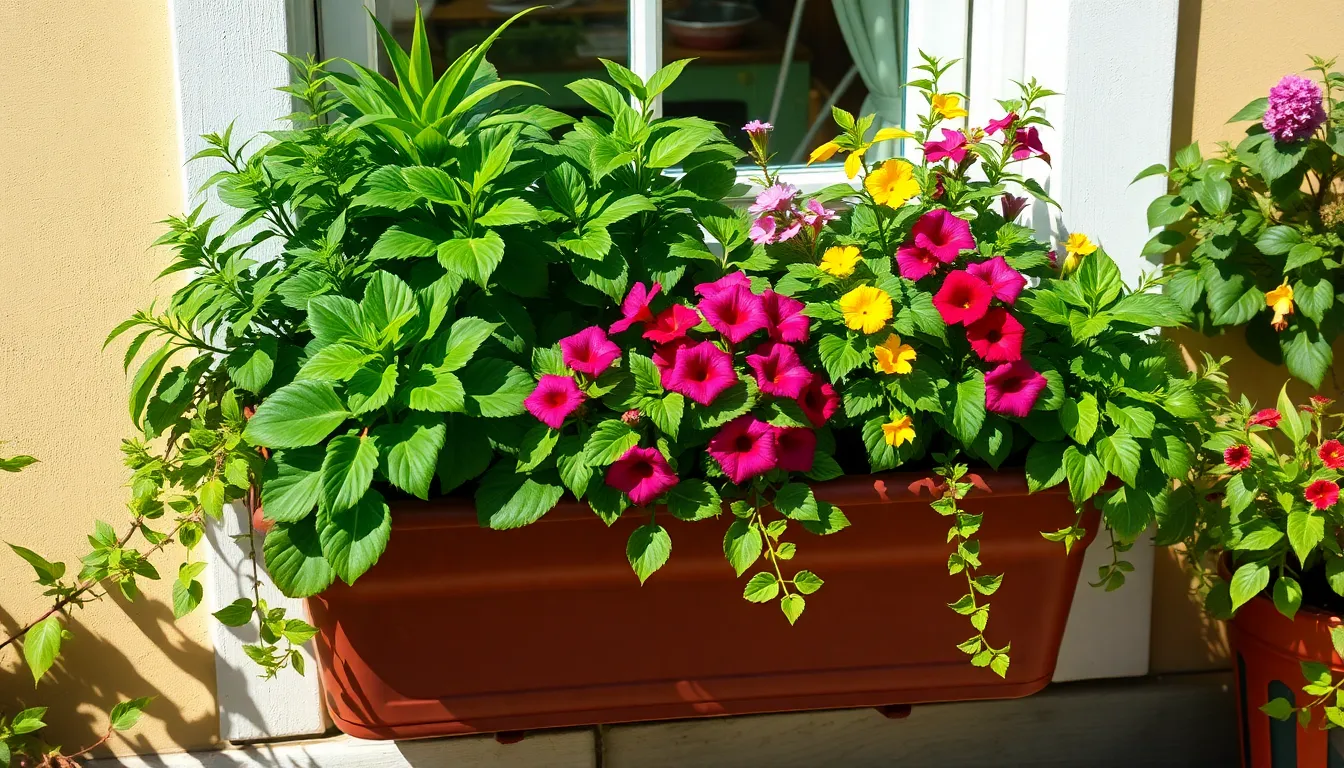
Proper care transforms shade window boxes from simple containers into thriving garden showcases. We’ll explore the exact requirements that keep these low-light gardens healthy and vibrant throughout the growing season.
Watering Requirements for Shade Conditions
Consistent moisture levels are crucial for shade window box success, but overwatering poses the biggest threat to plant health. We check soil moisture every few days by inserting our finger about an inch into the soil. Shade plants require less water than their sun-loving counterparts since evaporation rates decrease significantly in low-light conditions.
Gentle watering at the base prevents soil displacement and reduces mess while ensuring water reaches the root zone effectively. During hot and dry periods, we increase watering frequency to maintain even moisture without creating waterlogged conditions. Yellow leaves combined with a foul smell indicate root rot from excessive moisture, requiring immediate drainage improvements.
Avoiding complete soil dryness remains equally important since shade plants can’t tolerate drought stress. We maintain that sweet spot where soil feels consistently moist but never soggy to the touch.
Soil and Drainage Considerations
Well-draining potting mix specifically formulated for container gardening forms the foundation of successful shade window boxes. Standard garden soil becomes too heavy and retains excessive moisture in container environments. We select potting mixes that maintain some moisture retention while preventing waterlogged conditions.
Proper drainage holes are non-negotiable for preventing water accumulation, especially since shade conditions naturally slow evaporation rates. After initial planting, we water gently to settle loose soil around root systems. Regular debris removal keeps both plants and containers looking their best while preventing potential disease issues.
Container soil may appear loose initially, but watering helps compact it to the appropriate density for root development and stability.
Fertilizing Schedule for Optimal Growth
Balanced, water-soluble fertilizers provide the nutrients shade plants need for healthy foliage and flowering. We apply general-purpose fertilizer according to package directions, or switch to flower boosters when encouraging more blooms in our displays. Regular feeding during the growing season supports vigorous growth even though limited natural light conditions.
Excessive fertilization can harm plants more than under-fertilizing, so we follow product instructions carefully rather than assuming more is better. Shade plants typically require less frequent feeding than sun plants since their growth rates are naturally slower.
Nutrient deficiencies become more apparent in container environments, making consistent fertilizing schedules essential for maintaining the vibrant colors and healthy growth we expect from our shade window box displays.
Conclusion
We’ve shown you that shade doesn’t have to limit your window box gardening ambitions. With the right plant selections and proper care techniques you can create stunning displays that rival any sun-loving arrangement.
From low-maintenance ferns to vibrant coleus and practical herbs these shade-tolerant plants offer endless possibilities for your outdoor spaces. The key lies in understanding each plant’s exact needs and combining them strategically for maximum visual impact.
Your shaded window boxes can become focal points that bring life and color to overlooked areas of your home. With consistent moisture proper drainage and the right plant combinations you’ll enjoy beautiful displays that thrive in cooler conditions year after year.
Frequently Asked Questions
What are the best plants for shade window boxes?
The best plants for shade window boxes include foliage plants like coleus, caladium, and hosta, flowering plants such as impatiens, begonias, and torenia, and trailing varieties like ivy, bacopa, and creeping jenny. These plants thrive in low-light conditions and offer diverse colors, textures, and growth habits to create stunning displays.
Do shade plants require less maintenance than sun plants?
Yes, shade plants typically require less maintenance than sun plants. They need less frequent watering, reduced fertilization, and are generally more tolerant of neglect. Plants like ferns, heuchera, and ajuga are particularly low-maintenance options that provide beautiful displays with minimal care requirements.
Can I grow herbs in shaded window boxes?
Absolutely! Several herbs thrive in partial to full shade, including mint, parsley, and chives. These herbs not only add fresh flavors to your cooking but also adapt well to the naturally moist conditions of shaded window boxes, making them perfect for culinary gardeners with limited sunlight.
How often should I water shade window box plants?
Shade window box plants need consistent moisture but not overwatering. Check soil moisture regularly by inserting your finger about an inch deep. Water when the top inch feels dry, but ensure proper drainage to prevent root rot. Shade plants typically need less frequent watering than sun plants.
What soil should I use for shade window boxes?
Use well-draining potting mix specifically designed for containers. The soil should retain moisture while allowing excess water to drain freely. Avoid heavy garden soil that can become waterlogged. Good drainage is essential to prevent root rot and maintain healthy plant growth in shade conditions.
Can I create year-round displays with shade window boxes?
Yes, you can maintain vibrant shade window boxes year-round by choosing seasonal plant combinations. Spring pairs coleus with begonias and ivy, summer features heat-tolerant begonias with caladiums and ferns, while fall showcases deep-colored coleus with boxwood and trailing ivy for continued interest.
Do shade window box plants need fertilizer?
Shade plants require less frequent fertilization than sun plants. Use a balanced, water-soluble fertilizer every 4-6 weeks during the growing season. Over-fertilizing can lead to excessive foliage growth at the expense of flowers, so follow package directions and monitor plant response.
What are the best trailing plants for shade window boxes?
The top trailing plants for shade window boxes are ivy (evergreen year-round coverage), bacopa (delicate white flowers), and creeping jenny (vibrant golden-yellow foliage). These plants create beautiful cascading effects and add depth and movement to your window box displays while thriving in low-light conditions.







